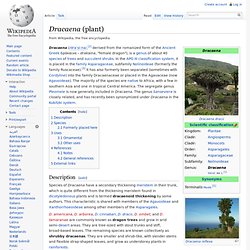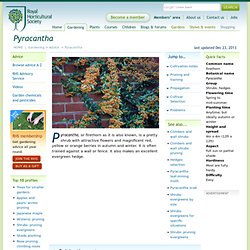

Dracaena (plant) Dracaena flower.

Species of Dracaena have a secondary thickening meristem in their trunk, which is quite different from the thickening meristem found in dicotyledonous plants and is termed dracaenoid thickening by some authors. This characteristic is shared with members of the Agavoideae and Xanthorrhoeoideae among other members of the Asparagales. D. americana, D. arborea, D. cinnabari, D. draco, D. ombet, and D. tamaranae are commonly known as dragon trees and grow in arid semi-desert areas. They are tree-sized with stout trunks and stiff, broad-based leaves. The remaining species are known collectively as shrubby dracaenas. There are around 110 species of Dracaena, including:[4] Asparagus asparagoides (L.)
Some shrubby species, such as D. deremensis, D. fragrans, D. godseffiana, D. marginata, and D. braunii, are popular as houseplants. A bright red resin, dragon's blood, is produced from D. draco and, in ancient times, from D. cinnabari. RHS Plant Selector Azara microphylla AGM. Eucalyptus. Some eucalyptus species have attracted attention from horticulturists, global development researchers and environmentalists because of desirable traits such as being fast-growing sources of wood, producing oil that can be used for cleaning and as a natural insecticide, or an ability to be used to drain swamps and thereby reduce the risk of malaria.

Outside their natural ranges, eucalypts are both lauded for their beneficial economic impact on poor populations[5][6]:22 and criticised for being "water-guzzling" aliens,[7] leading to controversy over their total impact.[8] Description[edit] Size and habit[edit] A mature eucalyptus may take the form of a low shrub or a very large tree. There are three main habits and four size categories that species can be divided into.
The term marlock has been variously used; in Forest Trees of Australia it is defined as a small tree without lignotubers but with a shorter, lower-branching trunk than a mallet. Tree sizes follow the convention of: Leucadendron. RHS Plant Selector Phlomis russeliana AGM. RHS Plant Selector Nandina domestica. Pyracantha. Pyracantha, or firethorn as it is also known, is a pretty shrub with attractive flowers and magnificent red, yellow or orange berries in autumn and winter.

It is often trained against a wall or fence. It also makes an excellent evergreen hedge. Cultivation notes Pyracantha can be grown as a free-standing shrub (or hedge), or trained against a wall or fence. Site and soil conditions Pyracantha is suitable for any moderately fertile garden soil in sun or partial shade, including very dry free-draining soils and heavy clays as long as they are not prone to water-logging. Planting If training Pyracantha along a wall or fence, plant at least 50cm (20in) out from the wall to avoid the dry area at the base. Before planting add a bucketful of well-rotted organic matter and 70-100g per sq m (2-3oz per sq yd) of balanced general purpose fertiliser to the soil.
Allow 1.5–3m (5-10ft) between specimen plants, but 50cm (20in) is fine between hedging plants. Watering and feeding Pruning and training Hedges. Viburnum. Viburnum is a genus of about 150–175 species of shrubs or (in a few species) small trees in the moschatel family, Adoxaceae.

Its current classification is based on molecular phylogeny.[1] It was previously included in the family Caprifoliaceae.[2] The member species are native throughout the temperate Northern Hemisphere, with a few species extending into tropical montane regions in South America, Russia and southeast Asia. In Africa, the genus is confined to the Atlas Mountains. In Ukraine it is seen as a national symbol. [citation needed] The generic name originated in Latin, where it referred to V. lantana.[3] The leaves are opposite, simple, and entire, toothed or lobed; cool temperate species are deciduous, while most of the warm temperate species are evergreen.
The flowers are produced in corymbs 5–15 cm across, each flower white to cream or pink, small, 3–5 mm across, with five petals, strongly fragrant in some species. Species[edit] Formerly placed here[edit] Other uses[edit]